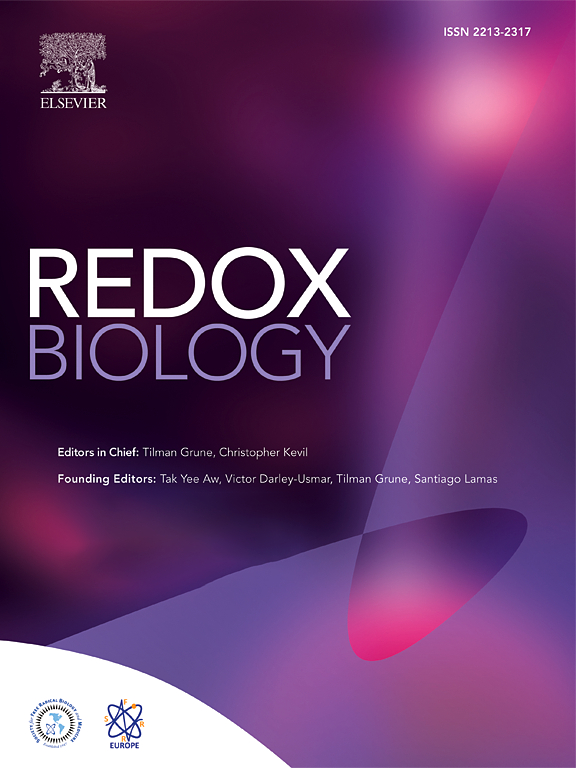Microgliosis, neuronal death, minor behavioral abnormalities and reduced endurance performance in alpha-ketoglutarate dehydrogenase complex deficient mice
IF 10.7
1区 生物学
Q1 BIOCHEMISTRY & MOLECULAR BIOLOGY
引用次数: 0
Abstract
The alpha-ketoglutarate dehydrogenase complex (KGDHc), also known as the 2-oxoglutarate dehydrogenase complex, plays a crucial role in oxidative metabolism. It catalyzes a key step in the tricarboxylic acid (TCA) cycle, producing NADH (primarily for oxidative phosphorylation) and succinyl-CoA (for substrate-level phosphorylation, among others). Additionally, KGDHc is also capable of generating reactive oxygen species, which contribute to mitochondrial oxidative stress. Hence, the KGDHc and its dysfunction are implicated in various pathological conditions, including selected neurodegenerative diseases. The pathological roles of KGDHc in these diseases are generally still obscure.
The aim of this study was to assess whether the mitochondrial malfunctions observed in the dihydrolipoamide succinyltransferase (DLST) and dihydrolipoamide dehydrogenase (DLD) double-heterozygous knockout (DLST+/−DLD+/−, DKO) mice are associated with neuronal and/or metabolic abnormalities.
In the DKO animals, the mitochondrial O2 consumption and ATP production rates both decreased in a substrate-specific manner. Reduced H2O2 production was also observed, either due to Complex I inhibition with α-ketoglutarate or reverse electron transfer with succinate, which is significant in ischaemia-reperfusion injury. Middle-aged DKO mice exhibited minor cognitive decline, associated with microgliosis in the cerebral cortex and neuronal death in the Cornu Ammonis subfield 1 (CA1) of the hippocampus, indicating neuroinflammation. This was supported by increased levels of dynamin-related protein 1 (Drp1) and reduced levels of mitofusin 2 and peroxisome proliferator-activated receptor gamma coactivator 1-alpha (PGC-1α) in DKO mice. Observations on activity, food and oxygen consumption, and blood amino acid and acylcarnitine profiles revealed no significant differences. However, middle-aged DKO animals showed decreased performance in the treadmill fatigue-endurance test as compared to wild-type animals, accompanied by subtle resting cardiac impairment, but not skeletal muscle fibrosis.
In conclusion, DKO animals compensate well the double-heterozygous knockout condition at the whole-body level with no major phenotypic changes under resting physiological conditions. However, under high energy demand, middle-aged DKO mice exhibited reduced performance, suggesting a decline in metabolic compensation. Additionally, microgliosis, neuronal death, decreased mitochondrial biogenesis, and altered mitochondrial dynamics were observed in DKO animals, resulting in minor cognitive decline. This is the first study to highlight the in vivo changes of this combined genetic modification. It demonstrates that unlike single knockout rodents, double knockout mice exhibit phenotypical alterations that worsen under stress situations.

α -酮戊二酸脱氢酶复合物缺乏小鼠的小胶质瘤、神经元死亡、轻微行为异常和耐力表现降低
α -酮戊二酸脱氢酶复合物(KGDHc),也被称为2-氧戊二酸脱氢酶复合物,在氧化代谢中起着至关重要的作用。它催化三羧酸(TCA)循环的关键步骤,产生NADH(主要用于氧化磷酸化)和琥珀酰辅酶a(用于底物水平磷酸化等)。此外,KGDHc还能够产生活性氧,这有助于线粒体氧化应激。因此,KGDHc及其功能障碍与多种病理状况有关,包括某些神经退行性疾病。KGDHc在这些疾病中的病理作用通常仍不清楚。
本文章由计算机程序翻译,如有差异,请以英文原文为准。
求助全文
约1分钟内获得全文
求助全文
来源期刊

Redox Biology
BIOCHEMISTRY & MOLECULAR BIOLOGY-
CiteScore
19.90
自引率
3.50%
发文量
318
审稿时长
25 days
期刊介绍:
Redox Biology is the official journal of the Society for Redox Biology and Medicine and the Society for Free Radical Research-Europe. It is also affiliated with the International Society for Free Radical Research (SFRRI). This journal serves as a platform for publishing pioneering research, innovative methods, and comprehensive review articles in the field of redox biology, encompassing both health and disease.
Redox Biology welcomes various forms of contributions, including research articles (short or full communications), methods, mini-reviews, and commentaries. Through its diverse range of published content, Redox Biology aims to foster advancements and insights in the understanding of redox biology and its implications.
 求助内容:
求助内容: 应助结果提醒方式:
应助结果提醒方式:


